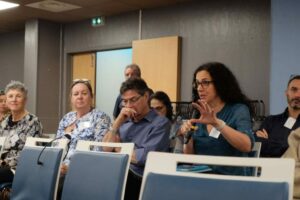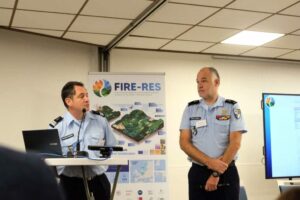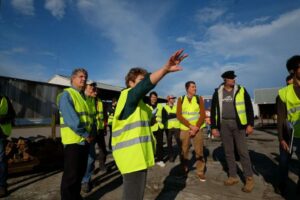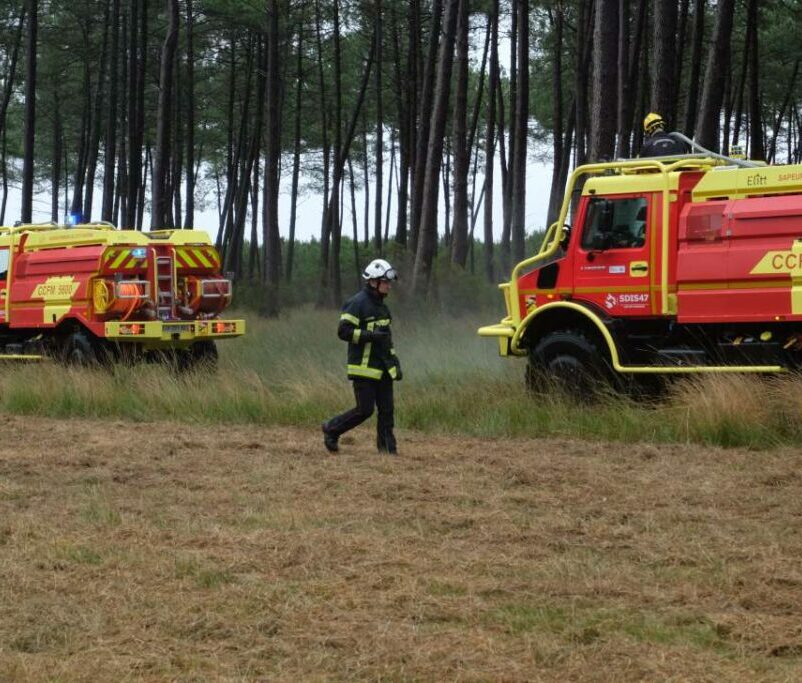 Over three days, the FIRE-RES project, coordinated by the Forest Science and Technology Centre of Catalonia (CTFC), brought together key stakeholders in Bordeaux and Mimizan to discuss innovative solutions to wildfire management. From cutting-edge technologies to sustainable landscape management, the meeting fostered collaboration across various sectors. Some core themes emerged transversally throughout the discussions.
Over three days, the FIRE-RES project, coordinated by the Forest Science and Technology Centre of Catalonia (CTFC), brought together key stakeholders in Bordeaux and Mimizan to discuss innovative solutions to wildfire management. From cutting-edge technologies to sustainable landscape management, the meeting fostered collaboration across various sectors. Some core themes emerged transversally throughout the discussions.
Financing Resilient Landscapes
A major topic was securing financial mechanisms to support long-term wildfire resilience. The Gironde Fire and Rescue Service shared insights on funding for fire services, while the National Forest Property Centre (CNPF) highlighted reforestation initiatives such as “France 2030” and the “Label Bas Carbone” system, used in the Landes region after the 2022 fires.
 Innovative funding models were also presented, like Groupama’s parametric forestry insurance, which uses satellite data to assess damages. Discussions focused on reforestation obligations and the need for public-private partnerships. Joan Cabezas, CEO of Nactiva-Palladium, emphasized that landscapes can serve as units of investment, with slow transformations driving risk mitigation. Initiatives like Blue Forest’s conservation finance and Forest Resilience Bonds, introduced by Tessa Maurer, were highlighted for their role in mobilizing private capital to fund forest restoration, stressing the importance of stakeholder engagement.
Innovative funding models were also presented, like Groupama’s parametric forestry insurance, which uses satellite data to assess damages. Discussions focused on reforestation obligations and the need for public-private partnerships. Joan Cabezas, CEO of Nactiva-Palladium, emphasized that landscapes can serve as units of investment, with slow transformations driving risk mitigation. Initiatives like Blue Forest’s conservation finance and Forest Resilience Bonds, introduced by Tessa Maurer, were highlighted for their role in mobilizing private capital to fund forest restoration, stressing the importance of stakeholder engagement.
Innovation and Technology in Wildfire Management
Technology was a central focus of the meeting, showcasing advancements in wildfire prevention and control. Tools such as drones, LIDAR, and GIS-based mapping promise to improve real-time decision-making and landscape monitoring. Participants explored the latest progresses from the FIRE-RES Innovation Actions, including the use of satellite data for fuel mapping in wildland-urban interface (WUI) zones, AI for vegetation classification, and simulations to predict fire behavior and assess the cost-effectiveness of fuel management techniques. Field demonstrations in the Landes forests highlighted LIDAR’s role in mapping fuel layers, and innovations like fire-resistant construction materials were also showcased.
Beyond technology, recent innovations in fire management are addressing economic incentives, policy frameworks, communication strategies and other tools. IA 2.4 introduced a scenario-planning framework for managing large landscapes, and IA 3.2 tested an incentive program in Catalonia to encourage landowners to reduce wildfire risks collectively. A parametric insurance model for privately owned forests in Catalonia was also discussed, providing financial safety nets for uninsured landowners. On the policy front, IA 4.5 is working toward a more coherent EU-wide framework for Integrated Wildfire Risk Management, while IA 4.8 focuses on improving real-time communication with citizens during wildfire events.
Sustainable Forest Management and Wildfires prevention: lessons from Nouvelle-Aquitaine
The host region, Nouvelle-Aquitaine, provided important lessons on adapting to wildfire risks. François Gros, General Inspector of the Préfecture de Région Nouvelle-Aquitaine, outlined the region’s strategic focus on transversality, shared awareness, and anticipation. The region prioritizes prevention by equipping forests and managing landscapes to limit fire damage. Local forest owners and restoration partners play a key role in these efforts.
 Yet, the 2022 wildfires in Landes de Gascogne were a harsh reminder of the landscape vulnerability, with fires spreading rapidly over thousands of hectares. This experience prompted local leaders to improve anticipation and response strategies, particularly in wildland-urban interface areas. Colonel Duverger (Landes SDIS) and Marc Vermeulen (Gironde SDIS) shared insights on the challenges they faced during the 2022 fires. The region’s cooperative forestry model, popular among private landowners, was highlighted for its role in maintaining effective forest management, while local sawmill FP Bois illustrated how cooperatives manage private forests profitably and sustainably. However, challenges remain, such as enforcing fuel control around homes and balancing the rise of solar energy projects with long-term forest sustainability.
Yet, the 2022 wildfires in Landes de Gascogne were a harsh reminder of the landscape vulnerability, with fires spreading rapidly over thousands of hectares. This experience prompted local leaders to improve anticipation and response strategies, particularly in wildland-urban interface areas. Colonel Duverger (Landes SDIS) and Marc Vermeulen (Gironde SDIS) shared insights on the challenges they faced during the 2022 fires. The region’s cooperative forestry model, popular among private landowners, was highlighted for its role in maintaining effective forest management, while local sawmill FP Bois illustrated how cooperatives manage private forests profitably and sustainably. However, challenges remain, such as enforcing fuel control around homes and balancing the rise of solar energy projects with long-term forest sustainability.
Participants also took part in hands-on simulations of fire prevention tools, guided by fire and rescue services from various French departments. Contributions from INRAE researchers, the National Forest Property Centre CNPF staff, and the regional forest defense association DFCI complemented these practical experiences.
Overall, the FIRE-RES project meeting was the perfect opportunity to take stock of all the progress achieved so far and set the scene for the upcoming final year of activities. The insights from all the speakers and participants demonstrated that addressing wildfire risks requires a multi-faceted approach. From financing models and technological innovations to adaptive governance and operational excellence, the path to resilient landscapes lies in collaboration.
Last modified: 15 October 2024










